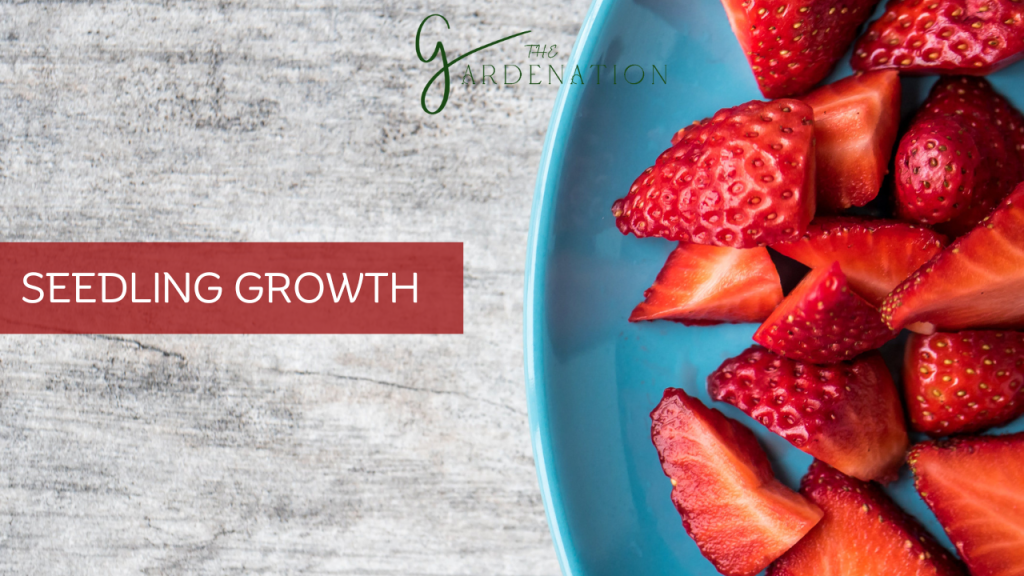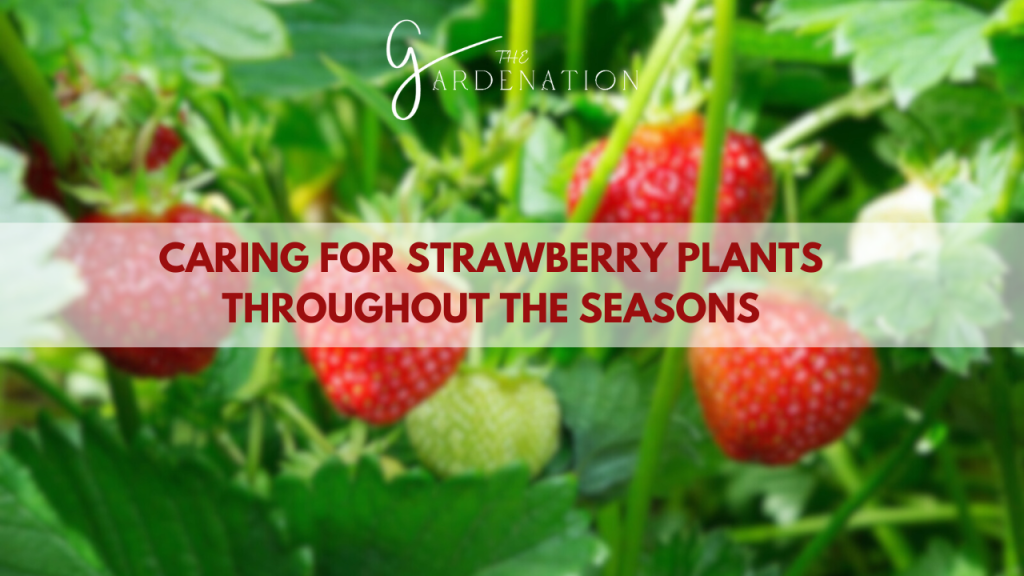Life Cycle Of A Strawberry Plant
With their sweet, succulent fruit and heart-shaped allure, strawberries captivate gardeners worldwide. Beyond producing a bountiful harvest, embracing the journey – nurturing plants from seedling to maturity – can be profoundly rewarding.
I have curated this guide for you to explore the life cycle of a strawberry plant, equipping growers with insider knowledge to reveal these charmers’ full potential.
We’ll traverse key milestones from seed sprouting to fruiting, uncover optimal growing conditions and demystify common hurdles. So let’s delve into the intricacies underpinning vibrant strawberry patches!
Strawberry Growth Stages

Behind luscious fruit lies a fascinating sequence. Growth initiates when seeds germinate below ground. Emerging seedlings expand small leaves. Pollinated blooms develop into aggregate fruits which swell into juicy berries.
Let’s examine each stage closer as we have done in: Cucumber Plant Life Cycle
1. Seed Germination

Planting the Seed: I began the strawberry life cycle with the planting of a strawberry seed in the soil.
Absorbing Water and Breaking Dormancy: The seed absorbs water, breaking its dormancy.
Emergence of a New Strawberry Plant: A new strawberry plant emerges, ready to grow and flourish.
For more information more about kitchen garden you can visit: Oregano Companion Plants
2. Seedling Growth

Green Shoot Emergence: A small green shoot pokes out of the soil, signaling the start of seedling growth.
Cotyledons Opening Up: The first two starter leaves, called cotyledons, open up.
True Leaves Starting to Grow: A few small true leaves start growing, setting the foundation for the plant’s future.
3. Development of Crowns

Leaf Multiplication: As more leaves grow during the strawberry life cycle, crowns begin forming at the soil level.
Clusters as Growth Hubs: Crowns become clusters from which new shoots, roots, and ultimately, strawberries emerge.
Abundance of Shoots: More crowns result in the abundant growth of shoots, leaves, flowers, and the much-loved strawberries.
4. Flowering

Triggered by Day Length: Day length triggers the plant to start flowering.
Clusters of Small White Flowers: Delicate clusters of small white flowers bloom on stalks, showcasing nature’s artistry.
Pollination and Fertilization: Pollination, facilitated by bees or the wind, results in fertilization, setting the stage for fruit formation.
Also do chekout!! 15 Zone 6 Fruit Trees to expand your knowledge.
5. Fruit Formation

Transformation from Flowers: Fertilized flowers transform into small green strawberries.
Steady Swelling: Over 2-4 weeks in the strawberry life cycle, the fruits steadily swell as sugars develop.
Color Change to Ripe Red: The strawberry skin changes from green to the vibrant red we associate with ripe strawberries.
6. Runner Production

Growing Shoots: Growing shoots, known as runners, begin spreading out.
Propagation of New Clones: Runners enable the parent plant to propagate new clones.
Formation of Daughter Plants: Daughter plants form as runners put down their own roots, continuing the strawberry plant’s cycle.
Strawberry Planting Season
Strawberries grow well in most temperate and subtropical climates in the spring. Delay heading north until the risk of frost decreases, which should happen between March and May.
Planting from October to February helps avoid climate change in the south. To promote development, I prepare raised beds that are enhanced with compost and a balanced fertilizer.
I increase moisture retention and drainage by weaving landscape fabric. To prevent weeds and control soil temperature, I place the planted site in direct sunlight.
Then, I transplant seedlings or plugs at an 18-inch spacing, or I try to find the ideal balance between plenty of elbow room and plants to pollinate each other!
The Beauty of Strawberry Flowers and Pollination

Flower clusters appear after 3–4 months of intense leaf growth, indicating the change from vegetative to reproductive growth. White flowers with five petals have prominent golden anthers ringing the yellow centers.
Visually stunning, this fleeting yet fruitful phase also marks a critical juncture – pollinator interactions soon determine harvest success.
Honeybees proved most efficient transferring pollen between female pistillate and male staminate flower parts which develop into strawberries once fertilized.
Supporting pollinators returns the favor ensuring vivid fruit for all!
Full Grown Strawberry Plant
The full-grown strawberry plant (Fragaria x ananassa) is a sight to behold, boasting not only succulent berries but a complex and fascinating anatomy. Understanding the key characteristics and structure of a mature strawberry plant is essential for both gardeners and enthusiasts alike.
Anatomy of a Full Grown Strawberry Plant
Root System
At the foundation of the strawberry plant lies its root system. The roots, hidden beneath the soil, play a crucial role in nutrient absorption and providing stability. The fibrous roots spread radially, forming a network that supports the entire plant.
Stem and Crown
Above the soil, the strawberry plant’s stem emerges, connecting to the crown—a central structure where leaves and flower buds originate. The crown is positioned at soil level and is pivotal for the plant’s growth and development.
Leaves
The leaves of a full-grown strawberry plant are characterized by their trifoliate structure. Each leaf consists of three leaflets, contributing to the overall vigor and health of the plant. These leaves are not only functional in photosynthesis but also serve as protective elements.
Runners
One distinctive feature of mature strawberry plants is the production of runners. These are horizontal stems that extend from the crown and eventually develop into new plants. Runners facilitate the plant’s natural propagation and expansion.
Flower and Fruit Formation
As the strawberry plant matures, it enters the flowering stage. The flowers, borne on the ends of stems, are vital for fruit production. The plant’s pollination process, often aided by bees, is a precursor to the development of the iconic, juicy strawberries.
Characteristics of a Full Grown Strawberry Plant

Size and Structure
A fully developed strawberry plant typically reaches a height of 6 to 8 inches, with an equal or larger spread. The compact size makes it suitable for both garden beds and containers. The structure is well-balanced, with healthy leaves and stems contributing to its overall aesthetics.
Fruit Yield
One of the most anticipated characteristics of a mature strawberry plant is its fruit yield. A well-cared-for plant can produce a bountiful harvest of plump, red berries. The fruit’s sweetness and flavor are influenced by factors such as soil quality, sunlight, and proper care.
Hardiness and Adaptability
Full-grown strawberry plants exhibit hardiness and adaptability to various climates. They thrive in well-draining soil and prefer ample sunlight. Their ability to withstand different growing conditions makes them a popular choice among home gardeners.
Seasonal Growth Cycle
Understanding the seasonal growth cycle is essential for cultivating a successful strawberry crop. From dormancy in winter to flowering and fruiting in spring and summer, the plant follows a distinct cycle. I provide proper care during each phase to ensure a continuous and healthy harvest.
Pest Resistance and Disease Tolerance
Mature strawberry plants often display resilience against pests and diseases. However, regular monitoring is crucial to identify and address any issues promptly. Common pests include aphids and spider mites, while diseases like powdery mildew can affect the plant.
Longevity and Renewal
While individual strawberry plants have a lifespan of about 2 to 3 years, they exhibit a unique renewal process through the production of runners. This allows for the continual growth of new plants, ensuring a sustainable strawberry garden.
Caring for Strawberry Plants Throughout the Seasons

While adaptable to various climates, tailored care optimizes strawberry success. Water needs to peak during the fruit set. Drip irrigation targeting crown level prevents moisture extremes. I apply balanced fertilizer when blooming commences and again once harvesting initiates.
Also, I add winter mulch shielding plants in colder zones. Challenges arise but preventative practices prevail!
I monitor for pests like spider mites, and I treat them with gentle organic miticide sprays. I remove old leaves to encourage air circulation.
Frequently Asked Questions About Life Cycle Of A Strawberry Plant
How often should I water strawberry plants?
I water strawberries when the top inch of soil dries out. I increase frequency during flowering and fruiting periods – around 2-3 times per week in warmer months for most climates. I also ensure soil moisture without oversaturating.
When is the best time to plant strawberries?
Early spring is ideal, allowing at least 6 weeks growing time before summer heat arrives. Northward, plant once frost danger passes from March-May. Down south, target October-February before temperature rises.
Do strawberries need special care when flowering?
Yes, I shelter flowers from late frosts covering plants overnight if needed. Support steady moisture levels and boost feeding to fuel the fruit formation process. I consider introducing native bee houses since insect pollination is essential for berry development.
Can I grow strawberries from seed rather than transplants?
You can grow strawberries from seed but this lengthens the strawberry life cycle,. Transplants establish quicker and bear fruit within a few months. However seeds allow you to propagate special heirloom varieties. I sow indoors 10-12 weeks before last spring frost.
How can I protect strawberries from common pests?
Lacing garden beds with food grade diatomaceous earth deters crawling pests. Support beneficial insects like ladybugs which prey on mites. I practice crop rotation, remove affected plants promptly and wash berries before consuming to sidestep problems.
How Long Do Strawberries Take to Grow?
From planting to fruiting, strawberries average 4-6 weeks – one of the fastest growing edibles!
However, the timeline varies by type. Day-neutral cultivars yield 60-90 days from seedling. June-bearers and everbearers take roughly 90-120 days before fruit emerges.
Factors like climate, irrigation and soil fertility also impact pace. Optimizing inputs, you could be plucking plump, ripe berries within a month of spying seedlings!


One Comment